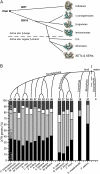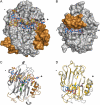The XTH gene family: an update on enzyme structure, function, and phylogeny in xyloglucan remodeling
- PMID: 20421457
- PMCID: PMC2879796
- DOI: 10.1104/pp.110.156844
The XTH gene family: an update on enzyme structure, function, and phylogeny in xyloglucan remodeling
Figures



Similar articles
-
Unraveling the functions of glycosyltransferase family 47 in plants.Trends Plant Sci. 2003 Dec;8(12):565-8. doi: 10.1016/j.tplants.2003.10.003. Trends Plant Sci. 2003. PMID: 14659703
-
The XTH family of enzymes involved in xyloglucan endotransglucosylation and endohydrolysis: current perspectives and a new unifying nomenclature.Plant Cell Physiol. 2002 Dec;43(12):1421-35. doi: 10.1093/pcp/pcf171. Plant Cell Physiol. 2002. PMID: 12514239 Review.
-
Xyloglucan endotransglycosylase, a new wall-loosening enzyme activity from plants.Biochem J. 1992 Mar 15;282 ( Pt 3)(Pt 3):821-8. doi: 10.1042/bj2820821. Biochem J. 1992. PMID: 1554366 Free PMC article.
-
Another building block in the plant cell wall: Barley xyloglucan xyloglucosyl transferases link covalently xyloglucan and anionic oligosaccharides derived from pectin.Plant J. 2020 Nov;104(3):752-767. doi: 10.1111/tpj.14964. Epub 2020 Sep 19. Plant J. 2020. PMID: 32799357
-
Broad Specific Xyloglucan:Xyloglucosyl Transferases Are Formidable Players in the Re-Modelling of Plant Cell Wall Structures.Int J Mol Sci. 2022 Jan 31;23(3):1656. doi: 10.3390/ijms23031656. Int J Mol Sci. 2022. PMID: 35163576 Free PMC article. Review.
Cited by
-
Nematode feeding sites: unique organs in plant roots.Planta. 2013 Nov;238(5):807-18. doi: 10.1007/s00425-013-1923-z. Epub 2013 Jul 4. Planta. 2013. PMID: 23824525 Review.
-
Genome sequencing of Elaeocarpus spp. stem blight pathogen Pseudocryphonectria elaeocarpicola reveals potential adaptations to colonize woody bark.BMC Genomics. 2024 Jul 24;25(1):714. doi: 10.1186/s12864-024-10615-5. BMC Genomics. 2024. PMID: 39048950 Free PMC article.
-
Analysis of xyloglucan endotransglycosylase/hydrolase (XTH) genes and diverse roles of isoenzymes during persimmon fruit development and postharvest softening.PLoS One. 2015 Apr 7;10(4):e0123668. doi: 10.1371/journal.pone.0123668. eCollection 2015. PLoS One. 2015. PMID: 25849978 Free PMC article.
-
Identifying plant genes shaping microbiota composition in the barley rhizosphere.Nat Commun. 2022 Jun 16;13(1):3443. doi: 10.1038/s41467-022-31022-y. Nat Commun. 2022. PMID: 35710760 Free PMC article.
-
Effect of wet storage conditions on potato tuber transcriptome, phytohormones and growth.BMC Plant Biol. 2019 Jun 17;19(1):262. doi: 10.1186/s12870-019-1875-y. BMC Plant Biol. 2019. PMID: 31208336 Free PMC article.
References
-
- Albersheim P. (1976) The primary cell wall. Bonner J, Varner JE, , Plant Biochemistry. Academic Press, New York, pp 225–274
-
- Atkinson RG, Johnston SL, Yauk YK, Sharma NN, Schroder R. (2009) Analysis of xyloglucan endotransglucosylase/hydrolase (XTH) gene families in kiwifruit and apple. Postharvest Biol Technol 51: 149–157
-
- Becnel J, Natarajan M, Kipp A, Braam J. (2006) Developmental expression patterns of Arabidopsis XTH genes reported by transgenes and Genevestigator. Plant Mol Biol 61: 451–467 - PubMed
Publication types
MeSH terms
Substances
LinkOut - more resources
Full Text Sources

